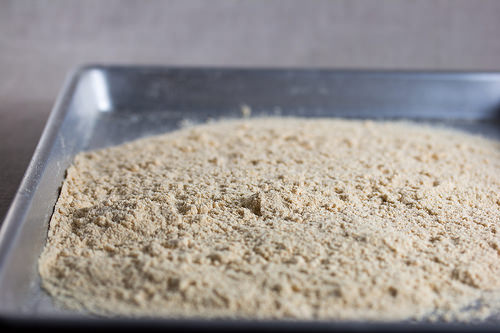Coconut (Cocos nucifera) is the Philippines’ wonder tree. Every part of it is used either for domestic or industrial purposes including the by-products. Sapal is one of the many by-products of coconut. It is the coconut meat left after extracting the milk. These are often thrown away since most people find no use for it.

But did you know that sapal could be made into coconut flour? And nutritious as well! This is the promise of a research conducted by Dr. Trinidad P. Trinidad of the Food and Nutrition Research Institute (FNRI) of the Department of Science and Technology (DOST). His study was presented during the recently held 17th National Coco Week.
According to Dr. Trinidad, the coconut flour from sapal is rich in dietary fiber, thus a promising functional food. Functional foods are those that provide health benefit beyond their basic nutrition. It is similar in appearance to conventional food and is consumed as part of usual diet. Functional food has demonstrated physiological benefits that reduce the risk of chronic disease.
A lot of our indigenous crops fall as functional foods due to their dietary fibers content. Some of these include the kampilan (red rice), kintab (a variety of mungbean), and recently, the coconut flour from sapal. Dietary fiber is important in preventing risk of colon cancer. It binds with bile acids and prevents its re-absorption in the liver, which inhibits cholesterol synthesis. It is also effective in controlling and managing diabetes mellitus and obesity by controlling the release of glucose in the body.
Dr. Trinidad used three parameters to determine the ‘functionality’ of coconut flour as food: fermentability, mineral availability, and the glycemic index.
The fermentability showed that there is a significantly greater dietary fiber content in the coconut flour than other local fiber sources like banana, cassava, wheat and rice flours.
He also found that the mineral availabile in coconut flour are: iron, zinc, calcium, and phytic and tannic acids. Moreover, as coconut flour itself is already a good source of dietary fiber, it does not affect the mineral content of other food when the coconut flour serves as an additive.
Glycemic index is a classification of foods based on their glucose response relative to a starchy food. This makes it therapeutic for diabetic and obese persons by slowing down carbohydrate absorption. Adding dietary fiber to food lowers the glycemic index and in turn reduces postprandial blood glucose and insulin responses. It improves the overall glucose and lipid concentrations in normal patients and those with diabetes. Foods supplemented with coconut flour have lower glycemic index.
Although a lot of people are still confused which food is functional and which is ‘just’ food, there is still a wide concern on which food is healthy and which is junk. A lot of people are more conscious in watching what they eat. Even though the Philippines has no available policy on functional foods it is still important that they be promoted to people. This will also prevent people from being misguided by false labeling of food.
With the discovery of coconut flour, production of sapal becomes an attractive endeavor for the coconut industry. It is nutritious. It is a good source of generating income.
—————-
Source:
“Coconut Flour from Sapal: A Promising Functional Food” by Dr. Trinidad P. Tinidad, paper presented during the 17th National Coco Week, 27 August 2003, PCA Auditorium, Diliman, Quezon City, Philippines.
by Rita T. dela Cruz, BAR Chronicle, September 2003 Issue (Vol. 4 No. 10)
